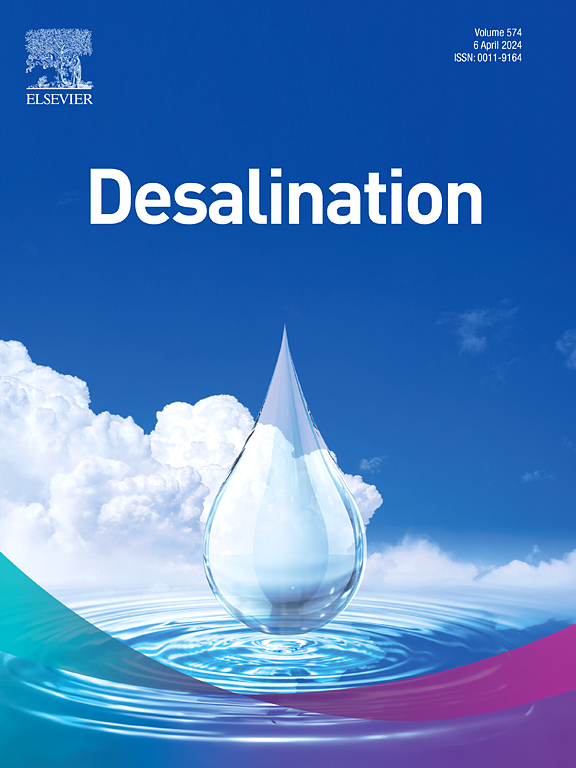Nanofiltration (NF) application in drinking water treatment plants and the challenges of its concentrate management in China
IF 8.3
1区 工程技术
Q1 ENGINEERING, CHEMICAL
引用次数: 0
Abstract
Nanofiltration (NF) technology, employed for water purification through size exclusion and charge separation, faces certain challenges. This review offers a comprehensive summary of the application of NF technology in drinking water treatment plants (DWTPs) across various regions in China, and the characteristics of NF concentrate (NFC). The quality of NFC exhibits variability at recovery rates of 40–60 %, despite consistent pollutant rejection across various NF membranes. Over a seven-year study, continuous operation of NF membranes was found to induce fouling, necessitating more frequent cleaning that damages the membrane structure. This leads to a doubling of NFC yield and a 30 % decrease in the retention of monovalent ions like chloride, with minimal impact on the retention of total hardness and sulfate. Temperature influences NF membrane recovery rates, which are 5–15 % higher in summer. Influent quality, productivity, and rejection efficiency variations significantly stress the final stage of a three-stage NF system. This review includes a study at two DWTPs using NF90 and NF270 membranes for treating saline groundwater and surface water contaminated with trace organic compounds (TrOCs), respectively. The study highlights challenges in managing NFC due to elevated levels of water quality parameters such as total dissolved solids, sulfate, chloride, total phosphorus, and TrOCs. Additionally, NF retains beneficial elements like strontium. It also assesses NFC composition and regional discharge standards for water bodies. This review offers valuable insights into the research and application of NF membranes in DWTP in China, and the water quality characteristics of NFC, facilitating a more comprehensive understanding of NF technology.

纳滤技术在中国饮用水处理厂的应用及其浓缩液管理面临的挑战
纳滤技术是一种通过粒径排除和电荷分离进行水净化的技术,它面临着一定的挑战。本文综述了纳滤技术在中国各地饮用水处理厂(dwtp)中的应用,以及纳滤浓缩液(NFC)的特点。尽管各种滤膜对污染物的截留一致,但NFC的质量在回收率为40 - 60%时表现出可变性。在一项为期7年的研究中,研究人员发现,连续操作纳滤膜会导致污染,需要更频繁地清洗,从而破坏膜结构。这导致NFC产率翻倍,单价离子(如氯离子)的保留率降低30%,对总硬度和硫酸盐的保留率影响最小。温度对纳滤膜回收率有影响,夏季纳滤膜回收率高5 - 15%。进水质量、生产效率和过滤效率的变化显著地强调了三级NF系统的最后阶段。本文综述了使用NF90和NF270膜分别处理含盐地下水和受微量有机化合物(TrOCs)污染的地表水的两个dwtp研究。该研究强调了由于水质参数(如总溶解固体、硫酸盐、氯化物、总磷和TrOCs)水平升高,NFC管理面临的挑战。此外,NF还保留了有益的元素,如锶。它还评估了NFC成分和水体的区域排放标准。本文综述了中国DWTP中纳滤膜的研究和应用,以及NFC的水质特征,有助于更全面地了解纳滤技术。
本文章由计算机程序翻译,如有差异,请以英文原文为准。
求助全文
约1分钟内获得全文
求助全文
来源期刊

Desalination
工程技术-工程:化工
CiteScore
14.60
自引率
20.20%
发文量
619
审稿时长
41 days
期刊介绍:
Desalination is a scholarly journal that focuses on the field of desalination materials, processes, and associated technologies. It encompasses a wide range of disciplines and aims to publish exceptional papers in this area.
The journal invites submissions that explicitly revolve around water desalting and its applications to various sources such as seawater, groundwater, and wastewater. It particularly encourages research on diverse desalination methods including thermal, membrane, sorption, and hybrid processes.
By providing a platform for innovative studies, Desalination aims to advance the understanding and development of desalination technologies, promoting sustainable solutions for water scarcity challenges.
 求助内容:
求助内容: 应助结果提醒方式:
应助结果提醒方式:


